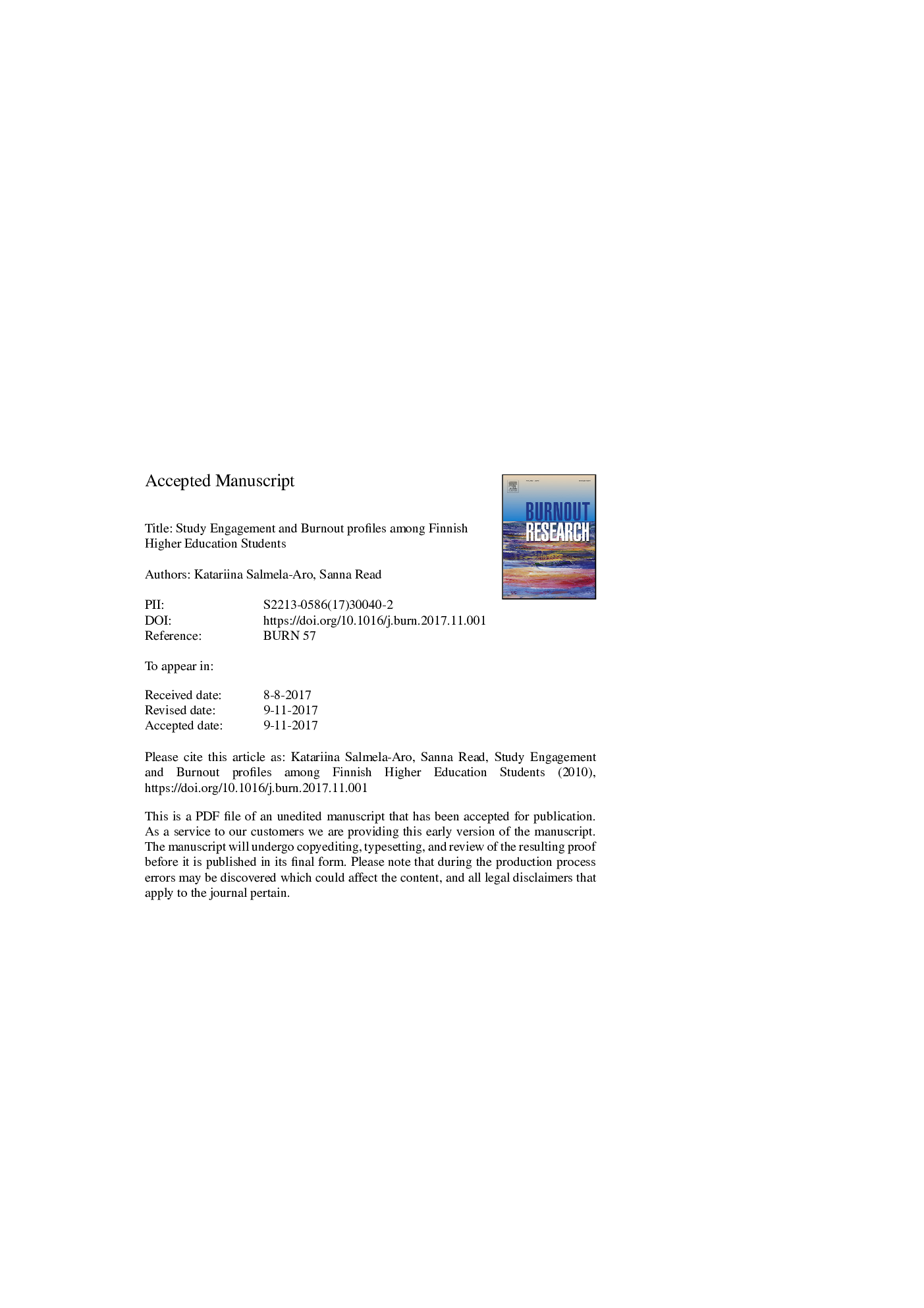| کد مقاله | کد نشریه | سال انتشار | مقاله انگلیسی | نسخه تمام متن |
|---|---|---|---|---|
| 6788477 | 1363316 | 2017 | 44 صفحه PDF | دانلود رایگان |
عنوان انگلیسی مقاله ISI
Study engagement and burnout profiles among Finnish higher education students
ترجمه فارسی عنوان
بررسی عوامل تعامل و فرسودگی در میان دانش آموزان تحصیلات عالی فنلاند
دانلود مقاله + سفارش ترجمه
دانلود مقاله ISI انگلیسی
رایگان برای ایرانیان
کلمات کلیدی
مطالعه فرسودگی شغلی؛ مشارکت تحصیلی؛ پروفایل ها؛ رویکرد شخصیتی؛ آموزش عالی؛ مرحله مطالعه؛ نیازهای منابع
ترجمه چکیده
یک رویکرد فردی برای شناسایی پروفیل های تعامل و فرسودگی تحصیلی (یعنی خستگی، بدبینی، ناکافی بودن) در آموزش عالی در نمونه ای بزرگ و نمونه ای از 12394 دانشجوی تحصیلات عالی در مراحل مختلف تحصیلات خود در دانشگاه ها و تکنیک های فنلاند در فنلاند استفاده شد . چهار پروفیل شناسایی شدند: مشغول (44٪)، مشغول خسته (30٪)، عدم توانایی (19٪) و سوخته (7٪). دانشجویان مشغول به کار با مثبتترین مشاغل همراه با علائم کم شنوایی در مقایسه با سایر گروهها بودند. دانش آموزان درگیر و خسته به طور همزمان با خستگی عاطفی روبرو شدند. گروه غیرضروری تجربه ناکافی را به عنوان یک دانش آموز افزایش داده است. دانش آموزان سوزانده شده بسیار بدبینانه و ناکافی بودند و تعارض بسیار کمی با سایر گروه ها داشتند. از این گروه ها، دانشجویان مشغول به تحصیل در مراحل اولیه تحصیل بودند، در حالیکه دانشجویان سوخته و غیرموثر در طولانی ترین دوره تحصیل کرده بودند. الگوی نشان می دهد که دانش آموزان از تعاملات بالا شروع می کنند و فرسودگی شغلی بعدا در حرفه تحصیلی شایع تر می شود. حمایت از مدل منابع خواسته-منابع، متغیرهایی که منعکس کننده مطالبات بودند بالاتر بود و منابع انعکاس دهنده در میان دانش آموزان سوخته و غیرموثر نسبت به دانشجویان مشغول به کار بود.
موضوعات مرتبط
علوم پزشکی و سلامت
پزشکی و دندانپزشکی
روانپزشکی و بهداشت روانی
چکیده انگلیسی
A person-oriented approach was applied to identify profiles of study engagement and burnout (i.e., exhaustion, cynicism, inadequacy) in higher education in a large and representative sample of 12,394 higher education students at different phases of their studies in universities and polytechnics in Finland. Four profiles were identified: Engaged (44%), engaged-exhausted (30%) inefficacious (19%) and burned-out (7%). The engaged students had the most positive engagement accompanied with the least burnout symptoms compared to other groups. The engaged-exhausted students experienced emotional exhaustion simultaneously with academic engagement. The inefficacious group had heightened experience of inadequacy as a student. The burned-out students showed very high cynicism and inadequacy and very low academic engagement compared to the other groups. Of these groups, the engaged students tended to be in the earlier stages in their studies, whereas the burned-out and inefficacious students had been studying the longest. The pattern suggests that students starting out with high engagement and that burnout becomes more common later in the academic career. Supporting demands-resources model, the covariates reflecting the demands were higher and those reflecting resources were lower among the burned-out and inefficacious students compared to the engaged students.
ناشر
Database: Elsevier - ScienceDirect (ساینس دایرکت)
Journal: Burnout Research - Volume 7, December 2017, Pages 21-28
Journal: Burnout Research - Volume 7, December 2017, Pages 21-28
نویسندگان
Katariina Salmela-Aro, Sanna Read,
